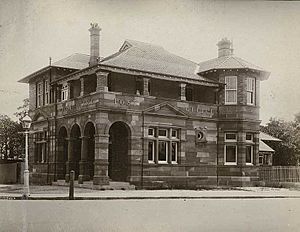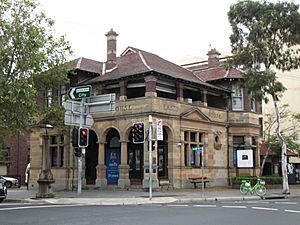Randwick Post Office facts for kids
Quick facts for kids Randwick Post Office (former) |
|
|---|---|

Randwick Post Office, undated
|
|
| Location | 124 Alison Road, Randwick, City of Randwick, New South Wales, Australia |
| Built | 1897–1898 |
| Architect | Walter Liberty Vernon (NSW Government Architect) |
| Architectural style(s) | Federation Free Classical |
| Owner | Australia Post |
| Official name: Randwick Post Office (former) and Jubilee Fountain | |
| Type | State heritage (built) |
| Designated | 23 June 2000 |
| Reference no. | 1409 |
| Type | Post Office |
| Category | Postal and Telecommunications |
| Builders | W. B. Chessell |
| Lua error in Module:Location_map at line 420: attempt to index field 'wikibase' (a nil value). | |
The Randwick Post Office is a special old building in Randwick, a suburb of Sydney, Australia. It used to be a post office, a place where people sent and received mail. This important building is located at 124 Alison Road.
It was designed by Walter Liberty Vernon, who was the main architect for the New South Wales Government at the time. The building was constructed between 1897 and 1898. Today, it is owned by Australia Post and is listed on the New South Wales State Heritage Register. This means it's a protected site because of its history and unique design.
Contents
History of Randwick Post Office
Early Indigenous History
Long before European settlers arrived, the local Aboriginal people lived in this area. They used the land for fishing and other cultural activities. You can still find signs of their presence, like rock carvings and special grinding grooves.
The Aboriginal people are thought to have lived around Sydney for at least 20,000 years. The Cadigal people lived south of Port Jackson, and the Muru-ora-dial clan lived near Maroubra. By the mid-1800s, their traditional way of life had changed greatly.
Randwick's Colonial Beginnings
One of the first land grants in this area was given to Captain Francis Marsh in 1824. He received about 4.9 hectares (12 acres) of land. Later, in 1839, William Newcombe bought land near the current town hall.
The name "Randwick" comes from a town in England called Randwick, Gloucestershire. Simeon Pearce and his brother James suggested the name. Simeon came to Australia in 1841 and bought land from Marsh, naming his property "Randwick." The brothers helped develop the areas of Randwick and Coogee.
Simeon Pearce worked to get a road built from Sydney to Coogee, which happened in 1853. He also pushed for Randwick to become its own town. In 1857, the first St Jude's church stood where the post office is now.
Life in Early Randwick
Randwick grew slowly at first. It was quite far from Sydney, with swamps and sandhills making travel difficult. A horse-bus service started in the late 1850s, but the journey was often bumpy. The bus could get stuck in the sand, and passengers sometimes had to help push it out!
Society in early Randwick was divided. Wealthy people lived in large, fancy houses. But many working-class people lived in smaller homes, working in market gardens or piggeries. Some even lived in simple huts or tents. There was also a very poor group of immigrants in an area called Irishtown, now known as The Spot. They lived in makeshift houses and did the hardest jobs to survive.
In 1858, the NSW Government passed a law allowing towns to form their own councils. Randwick was the first to apply and became a municipality in February 1859.
How the Post Office Started
In April 1859, people in Randwick asked the Postmaster General for a mail service. So, the first mail service began that year. A local store owner, John Grice, became the first postmaster, running the service from his store.
By 1887, the Randwick Council wanted a special building just for the post office. They found a piece of church land at Alison Road and Avoca Street. This land was bought in 1891.
In 1897, work began on the new post office building. W. B. Chessell was the builder, and Walter Liberty Vernon designed it. The new post office opened on 23 March 1898. It had a large main office, a room for the postmaster, and a telephone room. The postmaster also had a private home attached to the building with living rooms and bedrooms.
What the Post Office Looks Like
The Randwick Post Office is a two-storey building made of dark red bricks. It has a classic style with smooth sandstone on the street-facing walls up to the first floor.
The roof is made of terracotta tiles and has a complex shape. There are two brick and sandstone chimneys on the main building. You can see fancy decorations above the windows on the ground floor. There is also an arcade (a covered walkway) along Alison Road.
The roof extends over a first-floor balcony on one side. This balcony is supported by short brick and sandstone pillars.
Building Condition and Changes
The Randwick Post Office is in good condition today. It still looks much like it did when it was built. It has kept its special features, like its unique design and how it stands out in the area.
Over the years, some changes have been made to the building:
- Around 1920, post office boxes were added to the northern side.
- Bathrooms were added on both the ground and second floors.
- Part of the upper balcony was enclosed to create a storeroom.
- Some internal walls and partitions have been changed.
- Fireplaces were filled in, and a doorway on the eastern side was removed.
There is also a Telstra building next to the post office.
Why the Post Office is Important
The Randwick Post Office is important for its history, its beautiful design, and its value to the community.
It is historically significant because it was designed by Walter Liberty Vernon, a very important architect of his time. It also shows how communication services grew in Randwick as the population increased.
The building is aesthetically significant because it is a great example of the Federation Free style of architecture. Its design is very appealing, and its location makes it a landmark in Randwick. It really adds to the look of the area.
The Randwick Post Office is also important to the people of Randwick. It helps them feel connected to their local history and gives the area a special feeling.
This building was listed on the New South Wales State Heritage Register in 2000 because:
- It shows the history of communication services in New South Wales.
- It is a beautiful example of architecture by a famous government architect.
- It is important to the community's sense of place.
- It might hold clues about the past uses of the site.
- It is a fine example of Walter Liberty Vernon's work.
- It shows the main features of post offices built in the late 1800s in New South Wales.


